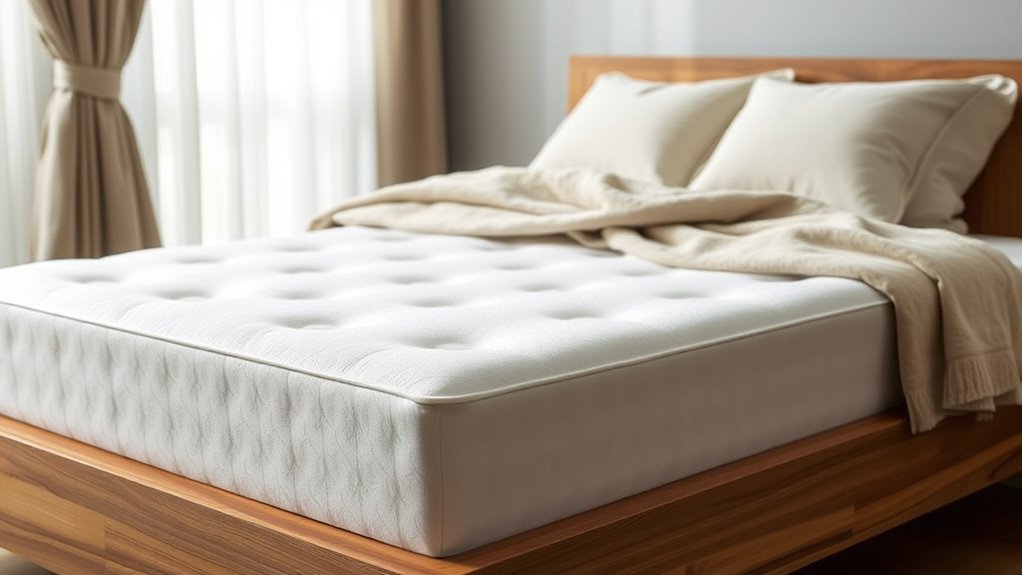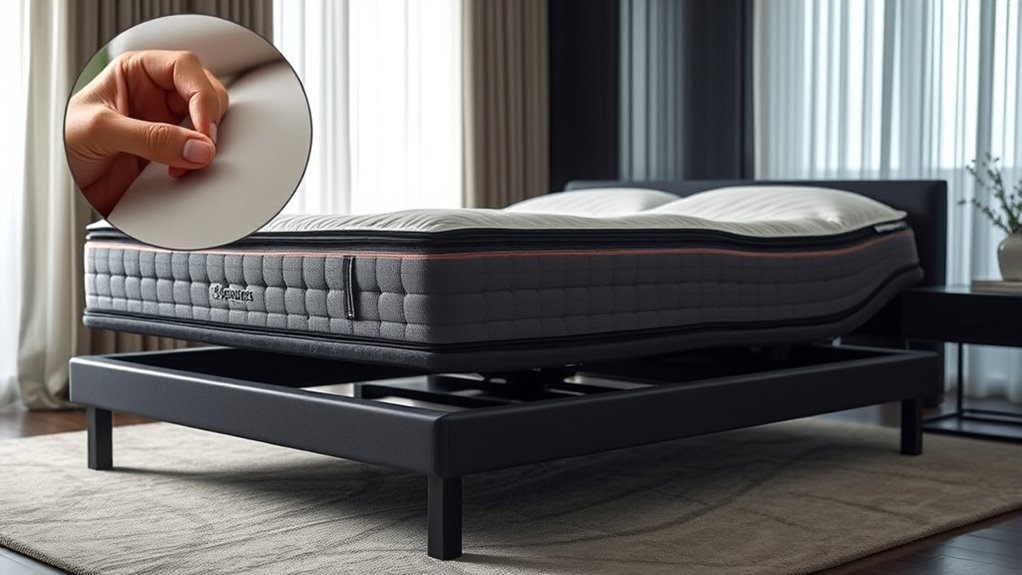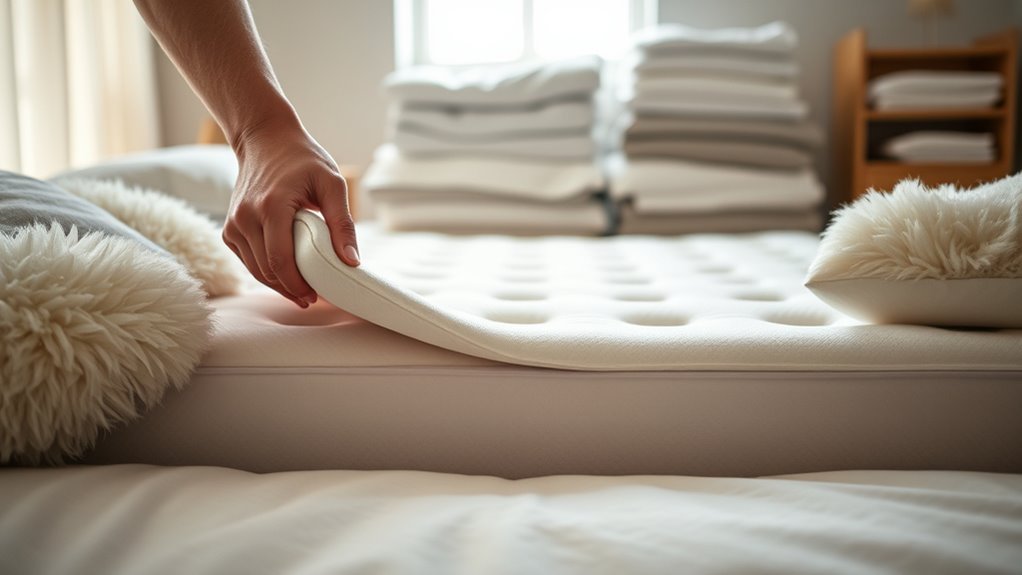If your mattress is too soft for back sleeping, start by evaluating its type and condition. Adding a supportive mattress topper can enhance firmness. Make certain your bed frame is sturdy and adjusted for ideal alignment. You might also place a sturdy board under the mattress for added support. Regularly rotating or flipping your mattress can help distribute wear. If discomfort persists, consider investing in a new mattress tailored for back sleepers to provide better support. There’s more to explore on improving your sleep.
Assess Your Mattress Type and Condition

When it comes to fixing a mattress for back sleepers, the first step is evaluating your mattress type and condition. Consider whether you have an innerspring, memory foam, or hybrid mattress, as each type supports sleep alignment differently. Check for sagging or wear that could jeopardize mattress longevity; these factors can lead to discomfort and poor support. If you notice indentations or uneven surfaces, it’s a sign that your mattress might not be suitable for your needs. Understanding your mattress’s condition helps you determine if it needs repair or replacement. Prioritizing sleep alignment is essential for back sleepers, as it guarantees your spine remains in a neutral position, promoting restful sleep and reducing the risk of back pain.
Use a Mattress Topper for Extra Support

If you’re looking to enhance your mattress’s support, a mattress topper can be a game changer. Consider the various material types available, such as memory foam or latex, each offering unique benefits for back sleepers. Additionally, pay attention to the thickness of the topper, as it can greatly influence your overall comfort and spinal alignment.
Material Types Explained
A mattress topper can greatly enhance your sleeping experience, especially for back sleepers who require ideal spinal alignment and support. Choosing the right material is essential.
| Material Type | Benefits |
|---|---|
| Memory Foam | Contours to your shape, relieving pressure points. |
| Latex Support | Offers responsiveness and durability, providing a supportive bounce. |
| Innerspring | Combines coils for durability with a traditional feel, maintaining breathability. |
| Hybrid Comfort | Blends foam and springs for the best of both worlds, ensuring support and comfort. |
Selecting the appropriate topper is important for achieving the freedom to sleep restfully. With the right material, you can transform your too-soft mattress into a haven for restorative sleep, ensuring your back feels supported all night long.
Thickness Considerations
Choosing the right thickness for your mattress topper is essential, as it directly impacts your comfort and support while sleeping on your back. The right thickness can enhance mattress firmness, ensuring your sleeping posture remains ideal. Here are some key considerations:
- 1-2 inches: Ideal for slight firmness adjustments without compromising softness.
- 3 inches: Provides a balance of support and plushness, perfect for back sleepers.
- 4 inches: Offers substantial support, great for those needing extra elevation.
- 5 inches or more: Best for severe mattress sagging, but can be too soft for some.
Select wisely to maintain your spine’s alignment and enjoy restful nights. Remember, the right thickness makes all the difference in achieving your desired comfort!
Adjust Your Bed Frame or Foundation

Adjusting your bed frame or foundation can greatly enhance your sleep quality as a back sleeper. A sturdy bed frame provides the necessary support, maintaining proper alignment of your spine. Make certain your frame is level and free from any creaks or wobbles; these can disrupt your rest. If you’re using an adjustable base, verify it’s set to the correct position for ideal foundation stability. Sometimes, bed frame adjustments can even improve how your mattress interacts with your body, offering a firmer feel. If you’re unsure, consult the manufacturer’s guidelines or consider professional advice. By taking these steps, you can create a more supportive sleep environment that fosters relaxation and freedom from discomfort.
Try Adding a Board Under the Mattress
If you’re struggling with back support, adding a board under your mattress could be a game-changer. It’s essential to choose the right type of board and place it correctly to enhance firmness without compromising comfort. Let’s explore how to select the perfect board and position it for maximum support.
Choose the Right Board
A sturdy board placed under your mattress can greatly enhance support for back sleepers. Choosing the right board is essential for achieving ideal comfort and alignment. Here are some factors to take into account:
- Board Materials: Opt for materials like plywood or MDF for durability and support.
- Board Sizes: Verify the board matches your mattress dimensions for a snug fit.
- Thickness: A thickness of at least 0.75 inches provides adequate firmness.
- Weight Capacity: Check that the board can support your weight without bending.
Proper Placement Techniques
To guarantee ideal support for back sleepers, placing the board correctly under your mattress is essential. First, verify the board fits snugly within the frame, providing a stable base. For best alignment, position the board directly underneath the mattress, avoiding gaps that can lead to instability. If your mattress has a specific height, adjust the board’s placement accordingly; it should elevate the mattress without making it too high for your bed frame. Use placement tips like checking for even distribution of weight across the board to prevent sagging. These adjustment techniques will enhance support, allowing your spine to maintain a neutral position. With careful placement, you can transform your sleeping experience and reclaim your comfort.
Rotate or Flip the Mattress
Regularly rotating or flipping your mattress can greatly enhance your sleep quality, especially for back sleepers. This simple practice promotes mattress longevity and guarantees ideal sleep alignment. Here’s how to do it effectively:
- Rotate your mattress every 3 to 6 months to distribute wear evenly.
- Flip your mattress (if it’s double-sided) at least twice a year to maintain firmness.
- Check for signs of sagging or unevenness each time you rotate or flip.
- Clean your mattress regularly to keep allergens at bay and improve hygiene.
Consider Investing in a New Mattress
If you’ve tried rotating or flipping your mattress without considerable improvement, it might be time to contemplate investing in a new one. A mattress that’s too soft can hinder your sleep quality, leading to discomfort and restless nights. When exploring new mattress brands, look for options specifically designed for back sleepers, as these usually offer better support and alignment. Consider materials like memory foam or hybrid models that provide a balance of comfort and firmness. Before purchasing, test several mattresses in-store or take advantage of online trials to find the best fit for your needs. Investing in a quality mattress tailored to your sleeping style can greatly enhance your overall sleep experience, giving you the freedom to wake up refreshed and ready for the day.
Frequently Asked Questions
How Do I Know if My Mattress Is Too Soft?
You’ll know your mattress is too soft if you struggle to maintain proper alignment while sleeping. If your back sinks too deeply and you wake up with discomfort, it’s a sign your mattress firmness isn’t supporting your sleep posture. A good mattress should keep your spine aligned, allowing your shoulders and hips to rest without excessive sinking. Trust your body; if you’re tossing and turning or waking up sore, it’s time to reassess.
Can I Use a Mattress Topper With Any Mattress Type?
Sure, you can use a mattress topper with almost any mattress type, but it’s essential to evaluate mattress compatibility. Different topper materials, like memory foam, latex, or gel, can change the feel and support of your mattress. If your mattress is too soft or too firm, picking the right topper can enhance your comfort. Just make sure it complements your mattress’s design and your sleep preferences for the best results.
Will a Firmer Pillow Help With Back Support?
Yes, a firmer pillow can markedly help with back support. It provides the necessary pillow height to maintain proper neck alignment, reducing strain on your spine. When your neck is aligned with your back, it promotes better posture and can alleviate discomfort. However, make sure the pillow isn’t too high, as that might cause additional issues. Finding the right balance will enhance your sleep quality and support your overall well-being.
How Often Should I Rotate or Flip My Mattress?
To keep your mattress as fresh as morning dew, you should rotate or flip it every three to six months. This simple act of mattress care not only promotes even wear but also enhances your sleep habits, ensuring you wake up rejuvenated. By giving your mattress a little twist, you’re fostering a balanced foundation, allowing for a harmonious night’s rest. Remember, consistency in care leads to longevity and comfort.
What Is the Lifespan of a Typical Mattress?
A typical mattress lasts between 7 to 10 years, depending on materials and durability factors. Memory foam and latex often outlast innerspring mattresses, which can sag sooner. Factors like usage, care, and body weight also play a role in how long your mattress will serve you well. Regularly rotating or flipping it can enhance its lifespan, helping you maintain comfort and support as you enjoy a good night’s sleep.



